Induction hobs of the famous brand Candy of various configurations and classes have already been in our laboratory, and now another one is next in line. The price of the CIS642MCTT can be described as “below average”, while all the functions inherent in advanced induction cookers are available: boost, and individual control for each burner, and a pause, and a multifunctional timer.

Characteristics
| Manufacturer | Candy |
|---|---|
| Model | CIS642MCTT |
| Type | built-in induction hob |
| Country of Origin | China |
| Warranty | 1 year |
| Service life * | 7 years |
| Material | glass ceramics |
| Control | touch, slider |
| Number of burners | 4 |
| Burner sizes | 18 cm |
| Minimum bottom diameter | 12 cm |
| Additional functions | timer (minute counter/switch off the hotplates after the time has elapsed), pause, keep food warm, power boost, auto-off, spill protection, overheating protection, residual heat indicator |
| Burner power | 2×2000(2600) W, 2×1500(2000) W (power in boost mode is given in brackets) |
| Maximum installed power | 7400 W |
| Weight (net/gross) | 8.5 kg / 9.8 kg |
| Dimensions (W×H×D) | 590×520×55 mm |
| Niche size for embedding | 560×490 mm |
| Network cable length | 1m |
| Retail offers |
* If it’s quite simple: this is the period during which parts for repairing the device are delivered to official service centers. After this period, any repair in the official SC (both warranty and paid) is unlikely to be possible.
Equipment
The hob arrived for testing in a technological box, on which we saw only the manufacturer’s logo and the type of device.

Opening the box and getting rid of the foam “airbags”, we found:
- the panel itself with an electric cord without a plug;
- a set of fasteners and screws;
- instructions and warranty card.
At first sight
The stove looks standard: a black glass-ceramic panel, 4 burners are marked with circles: in the center of each there is a dot, it is above it that the center of the dishes should be located. Under the burners is the control panel.

It is clear to the user who is more or less familiar with induction panels what functions are included in the CI642MCTT: we see a timer, a pause function, a touch panel lock, keeping food warm and a booster – a short-term increase in the power of the burner.
On the reverse side, we found two fans hidden behind a plastic casing.

Infrequently, to put it mildly, plastic is used in the manufacture of plate parts, but it is induction that allows the manufacturer to save money in this way: the panel simply does not heat up enough to melt the plastic. And such a move only benefits the buyer, because the price and weight of the device are reduced.
Instruction
The instruction manual is written in 9 languages at once, therefore it is a weighty Talmud. The Russian-speaking block hid exactly in the middle.

The instruction is written for two models at once, but they differ only in the number of burners, so all instructions are given immediately for both.
The manual is written in detail, each section is accompanied by illustrations. The manual also contains useful tips for identifying and eliminating the causes of minor problems, as well as a detailed description of the installation of the device.
Control
The stove is turned on by touching the corresponding icon, to select a burner, you need to touch the power scale related to it.

The panel control is touch and slider, that is, you can increase or decrease the heating of the burner by touching or sliding your finger along the scale. The second option is more accurate: you can poke in the wrong direction and turn on 7 instead of power level 4. There are 9 power levels in total, and they are not marked on the scale.
Each burner has its own personal “switches” for the booster and the keep food warm function, they even kindly indicate the time during which you need to hold your finger on the icon in order for the function to be activated.
Booster means an increase in burner power for 5 minutes: 1500 W burners accelerate to 2000 W, 2000 W to 2600 W. After the specified time has elapsed, the burner automatically switches to mode 9. The burners are divided into two blocks: two on the left and two on the right (that is, each block contains both a burner with a low power and a burner with a higher power). The booster can only be used for one burner in the block, and the power of the second should not exceed 5. If the booster does not turn on, then the permissible power of the panel has been exceeded – it can be increased using simple manipulations, for this the “Power Control” section of the instruction is useful, already mentioned in the “Instructions” chapter.
The keep warm mode (indicated by the picture of a steaming pan) means that the burner heats up just barely so that the food does not cook, but simply does not cool down. In this case, indicator A lights up above the scale of the corresponding hotplate.
The timer can be set as an elementary time counter (up to 99 minutes), even if no hotplates are switched on. To do this, simply touch the icon with the clock and set the time using the “+” and “-” buttons. Short touch – 1 minute, long touch – 10 minutes. In this case, after the time has elapsed, the stove will simply emit a sound signal. And you can set the time after which the heating zone will turn off – this can be done with all the burners at once, setting its own turn-off time for each. The timer window will show the smallest set time. If you have set a countdown for several cooking zones, you can see how much time is left for one of them to work by simply touching the corresponding scale: the remaining time will be displayed in the timer window. To set a “personal” timer for a burner, touch the scale corresponding to it, then the timer icon, then select the time. The timer indicator will flash for five seconds, after which you can continue to work.
Button II turns on the pause function: when it is activated, all burners are turned off, while “remembering” the modes in which they were. When the button is pressed again, the hob will resume operation at the set power.
For safety reasons, the stove automatically turns off after a certain time. This is worth keeping in mind when preparing something long-lasting, such as jelly, which is usually boiled for many hours.
| Mode | one | 2 | 3 | 4 | 5 | 6 | 7 | eight | nine | A | II |
|---|---|---|---|---|---|---|---|---|---|---|---|
| Shutdown time (hours) | eight | eight | eight | 4 | 4 | 4 | 2 | 2 | 2 | 2 | 2 |
Exploitation
Of course, the main feature of induction cookers is that they are only compatible with special cookware, an unsuitable pan simply will not heat up. If you purchased such a hob for the first time and also had to invest in new pots and pans, these costs will pay off sooner or later: induction “eats” significantly less electricity than a conventional stove.
The stove is relatively inexpensive (prices for other inductions are six-figures), we didn’t expect anything breathtaking in terms of functionality, and yet the possibilities inherent in it are enough to make the usual cooking noticeably more comfortable. Everything boils, especially in booster mode, very quickly. When changing power, the intensity of heating changes rapidly: if the broth suddenly boils strongly, switching back a couple of modes may be enough to quickly calm it down. The function of keeping food warm is very handy when everything is ready, and the household has not yet gathered at the table. Turning off the burners by timer is great, you can leave something that does not require constant supervision on the conscience of the stove and do other things.
Speaking of fast boiling: at this stage, you should not deviate from the CIS642MCTT. Spill protection turns off the stove when liquid is detected on the touch panel: splashing water from the ladle will stop the device from working, so be vigilant – at least for the first couple of minutes. But even if you missed this moment, the stove will inform you that it has turned off with a loud beep.
Another nice feature of the CIS642MCTT is that there is no need to select a pan for the size of the burner: it happens that such stoves simply ignore dishes with a small bottom diameter, but here the permissible minimum is 12 centimeters.
Care
The care rules are standard for glass ceramics: light dirt is removed with a sponge or soft cloth, serious dirt is removed with a special scraper. No abrasive cleaners and knives – ruin the surface. Although one knife can be used: for some reason, the manufacturer gave the go-ahead for a fish one.
The sensors are very sensitive, so if you want to wipe the stove while it is working (for example, splashed oil makes you nervous), the control panel should be locked by pressing the padlock icon.
Our measurements
In the off state, the stove consumes 0.2 watts. On when no burner is working – 6 watts.
We measured the power consumption in different modes. From 1 to 5, the heating level is regulated by the panel on / off periods, from mode 7 the power is kept constant. In the operation of the panel in mode 6, we could not identify any system: from 30 seconds to several minutes, the burner heated “at full”, and then for a couple of seconds the power dropped, but not to a certain mark, but randomly giving out indicators from 8 to 500 W. In the graphs, this point is reflected by a gap.
The average power was calculated using the formula: power consumption (maximum recorded) × on duration / (on duration + pause duration).
Burner 1500 W:
| Mode | Power consumption, W | Turn-on time, s | Turn-off time, s | Average power |
|---|---|---|---|---|
| one | 970 | 2 | thirty | 89 |
| 2 | 1510 | 2 | 20 | 94 |
| 3 | 1650 | 4 | fifteen | 125 |
| 4 | 1640 | 5 | nine | 585 |
| 5 | 1600 | 5 | 3 | 1000 |
| 6 | 1580 | haphazardly | haphazardly | there is no data |
| 7 | 1140 | — | — | 1140 |
| eight | 1250 | — | — | 1250 |
| nine | 1440 | — | — | 1440 |
| boost | 1960 | — | — | 1960 |
In graph form, it looks like this:

Burner 2000 W:
| Mode | Power consumption, W | Turn-on time, s | Turn-off time, s | Average power |
|---|---|---|---|---|
| one | 1040 | 2 | thirty | 65 |
| 2 | 980 | 3 | 20 | 130 |
| 3 | 1270 | 3 | fifteen | 210 |
| 4 | 1420 | 5 | thirteen | 395 |
| 5 | 1400 | 5 | 5 | 700 |
| 6 | 1300 | haphazardly | haphazardly | there is no data |
| 7 | 1180 | — | — | 1180 |
| eight | 1250 | — | — | 1250 |
| nine | 1800 | — | — | 1800 |
| boost | 2570 | — | — | 2570 |
In graph form, it looks like this:

In our standard test, boiling a liter of water at 20°C (bottom diameter 12 cm, lid closed), the panel showed the following results:
- Burner 1500 W, boost: bottom boil after 1 minute 10 seconds, vigorous boil after 3 minutes 50 seconds. Energy consumption – 0.125 kWh, power – 1900 watts.
- Burner 2000 W, boost: bottom boil after 1 minute 10 seconds, vigorous boil after 2 minutes 50 seconds. Energy consumption – 0.015 kWh. Power – 2500 watts.
We also measured the diameter of the ring inside which the heating takes place.
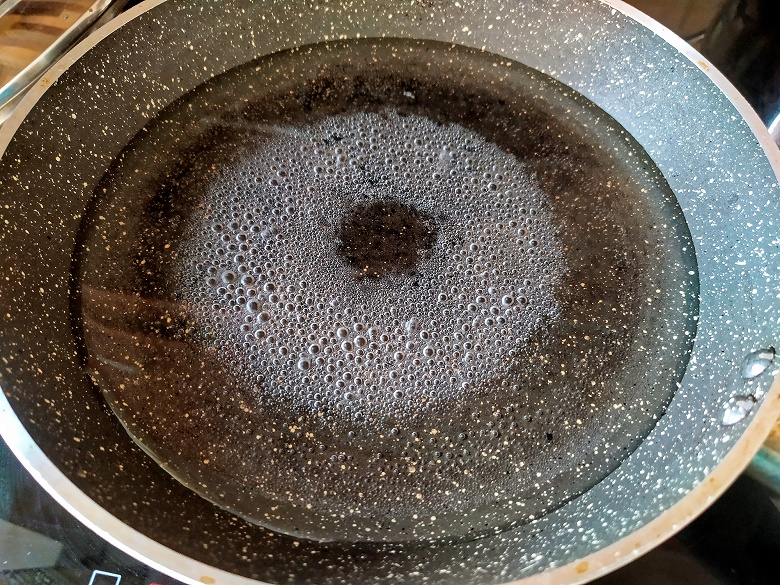
The diameter of the outer circle is 12 cm, the inner circle is 3 cm.
practice tests
Our favorite testing phase has finally arrived! We remove the rulers and other measuring instruments (okay, let’s leave the wattmeter), we take out the pans and pots, after all, the task of the stove is to cook. Under our strict guidance CIS642MCTT mastered:
- Syrniki
- beef broth
- Borsch
- lazy cabbage rolls
- Salad “Tashkent”
- Pad thai with chicken
Syrniki
A good day starts with a delicious breakfast. 360 grams of cottage cheese, one egg, a little semolina and flour were mixed, they were allowed to stand for a while so that the semolina swelled, and they stuck cheesecakes, which were sent to the pan a little rolled in flour.

In mode 6, they were fried to a crust, then brought to readiness in mode 3-4. In the center of the pan, cheesecakes were fried a little faster: the photo shows that the central one is slightly darker than those on the sides. But the gap was insignificant.

In half an hour we dealt with all the prepared dough. Energy consumption was 0.5 kWh, but the main thing is that the cheesecakes turned out to be ruddy and tasty.
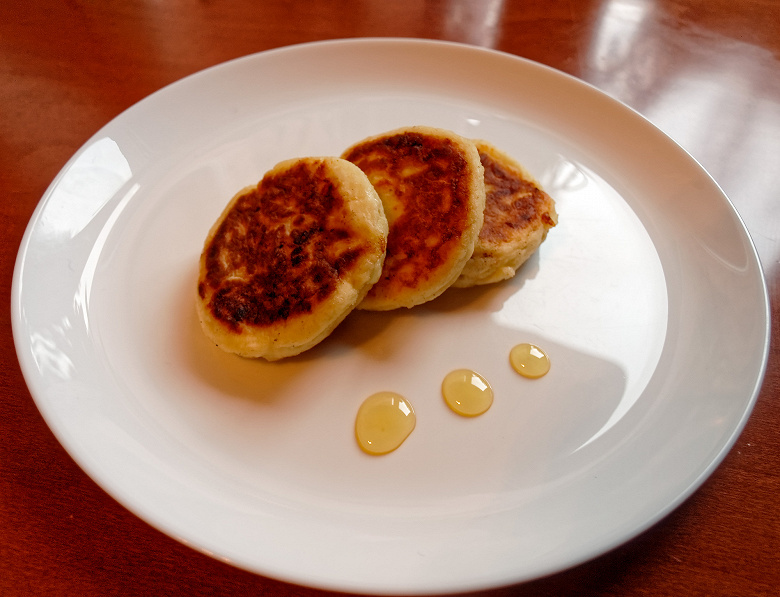
Result: excellent.
beef broth
By preparing the broth, we kill two test birds at once: we check the booster mode and the ability of the stove to maintain a low temperature. So, a good piece of beef brisket was poured with filtered water and, turning on the booster, brought to a boil. Bearing in mind that the mode automatically turns off after 5 minutes, we were on the lookout to switch back to it in time. The 3.5 liter pot was filled almost to the brim, but with the booster, the boil came in just 8 minutes. Having removed the foam, they sent carrots, an onion studded with cloves, celery root and stalks and a bunch of garni to the meat. On mode 7, the broth was brought to a boil, then the power was reduced to 4 and left under a slightly ajar lid.
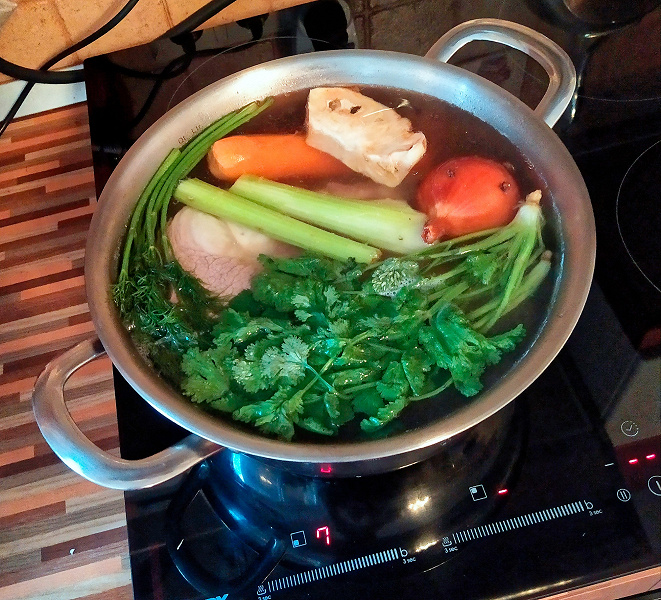
The broth was cooked for 2.5 hours. During this time, we periodically checked how he was doing there, sometimes we reduced the power to 2, if the boil was too strong, if it subsided, we raised it to 4. Unfortunately, we did not find the ideal mode to achieve a constant measured gurgling.
An hour later, vegetables that had already given up all their flavors were taken out of the broth, the meat was cooked for another hour and a half. And yet, our manipulations with the regimes were not in vain: we got an excellent transparent, rich broth.
Energy consumption was 1.2 kWh.

Result: good.
Borsch
The broth is there, it would be necessary to fill it with something. Scraped at the bottom of the barrel – be borscht!

We put two frying pans to heat up in mode 7: onion and carrots will be sautéed on one, and beets will be stewed on the other. They abandoned the vegetables, reduced the power to 4. Slightly warmed the beets in oil, splashed a few tablespoons of broth into it, covered it with a lid and left it to stew. At the same time, the broth was heated up.

Ground tomatoes were found in the refrigerator – they were added to onions and carrots, a couple of bay leaves and allspice were also thrown there. At this time, the broth boiled, they threw in the meat removed from the bone and chopped large potatoes – for greater satiety.
At this time, the beets came up. We pushed it to the edges, fried a little tomato paste in the center of the pan and mixed everything. When the potatoes were cooked, they put cabbage in the pan so that it remained slightly crispy, a little later they added onion-carrot dressing and beets. It remains to add dried dill and crushed garlic, turn off the stove and let the borscht brew.
An hour of time, 1.2 kWh – to eat, as they say, served!
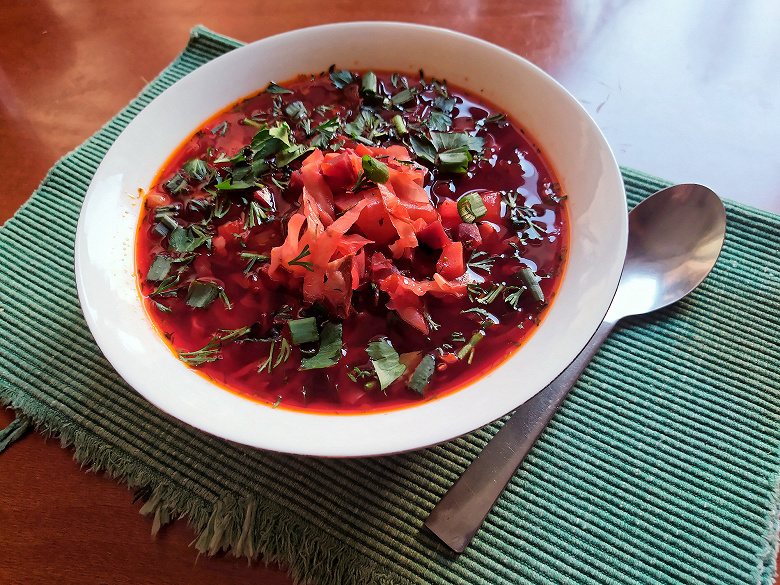
Result: excellent.
lazy cabbage rolls
It is not very clear why these cabbage rolls are lazy: the hassle with them is not much less than with the usual ones, but what a delicious result!

A little oil was poured into the pan and fried onions and carrots, minced meat was added. Cabbage was caramelized on the next burner to make the taste richer.

At this stage, a mistake lay in wait for us: according to an old habit developed by good old electric stoves, we began to fry minced meat with vegetables in the middle, fifth, mode. But it was too much: the contents of the pan almost burned, but we felt something was wrong in time and went to a more calm four. At this point, the cabbage was caramelized, sent it to the minced meat, put raw rice, bay leaf, salt, poured some water.

The matter remained small: they programmed the burner to turn off after half an hour, covered the pan with a lid and left to write an article. After 30 minutes, the stove squeaked invitingly, turning off at around 0.8 kWh. Stuffed cabbage came out excellent, the rice was stewed, but not boiled soft. The tasters really enjoyed it.
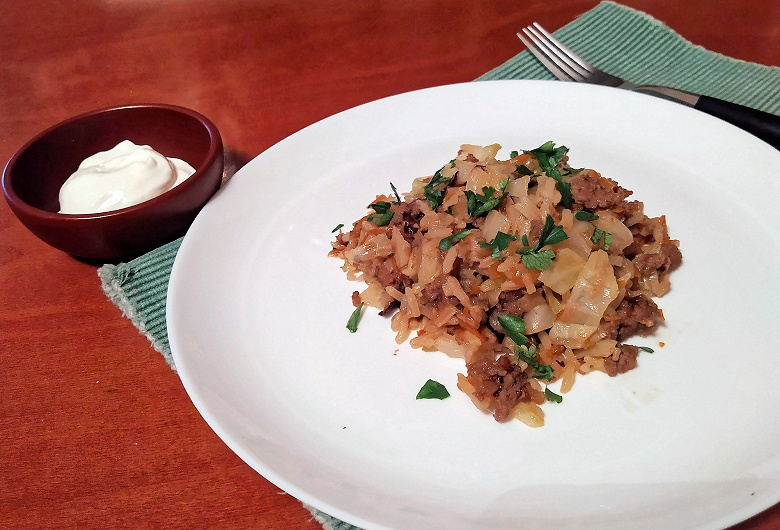
Result: excellent.
Salad “Tashkent”
Slowly getting to cooking at high temperatures, we decided to start with deep fat. The fried onion is just right at Tashkent, and it’s much more interesting to fry it until crispy to add texture to the salad.
The onion was cut into thick half rings, rolled in flour and shaken in a sieve so that the excess flour does not burn. In a wok, vegetable oil was heated to 180 ° C, mode 7 did an excellent job with this. The onions were fried in portions, laid out on a paper napkin and sprinkled with a mixture of salt, cumin and red pepper.

The stove did an excellent job of maintaining the temperature, the oil did not cool down and did not overheat, so the onions quickly fried and became pleasantly golden.
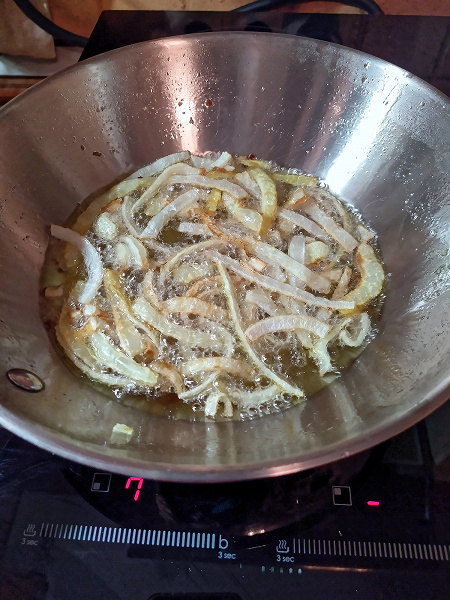
We used boiled beef as a protein component. They decided to fry part of the meat in the remaining oil: it took seconds. While the onion and meat were cooling, they quickly cut the green radish and daikon that had lain in cold water into cubes. Everything was mixed, seasoned with homemade mayonnaise, cilantro and red chili.

Result: excellent.
Pad thai with chicken
Asian cuisine is a real test for a home stove, and also a budget one. As always when cooking in a wok, we need the stove to constantly maintain a high level of heat without overheating. Well, let’s make some pad thai and check it out.
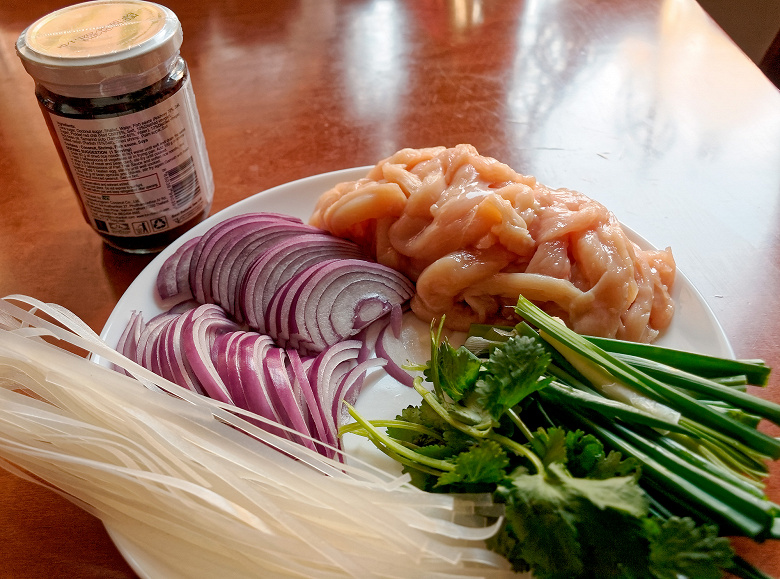
To begin with, rice noodles were poured with warm water: they should stand for 15 minutes – then they will reach in a pan. Oil was heated in a wok and the chicken was thrown in. We started working on mode 9, but the heating was so intense that we switched to 8 so as not to burn everything at the very beginning. Even though we miscalculated the volume and plopped a large portion of meat into the wok, it did not stew, but was instantly fried.

The finished chicken was laid out, first onion was sent in its place, then a little garlic was thrown. Half a minute later, noodles, chicken and tamarind sauce (we took ready-made from a can) went to them.
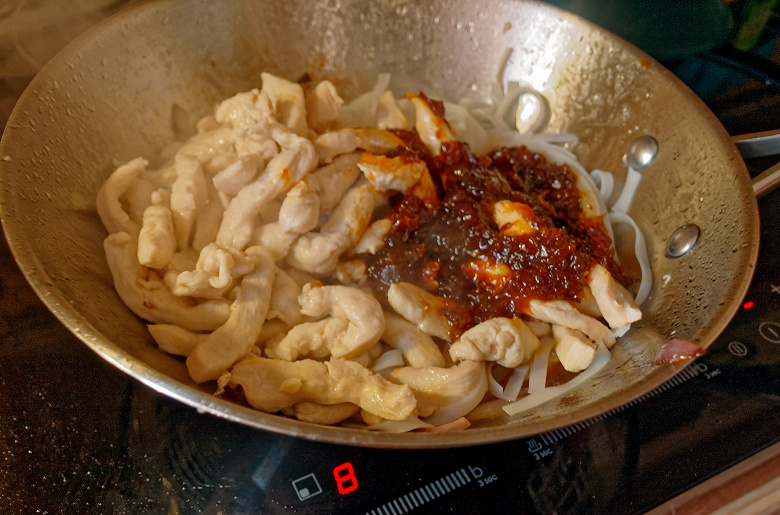
They warmed everything together for a couple of minutes, then moved the contents of the wok to the side, broke 2 eggs into the vacant corner and quickly stirred it.

When the egg was ready, everything was mixed, coarsely chopped green onions and crushed peanuts were added. For lack of soy sprouts on hand, they put daikon, cut into strips – looking ahead, it fit perfectly and gave the dish a crispy texture.

Served with cilantro and chili, drizzled with lime juice and sprinkled with peanuts. Another exam passed!
Result: excellent.
findings
We spent a month with the CIS642MCTT side by side, and during this time we did not have a single serious conflict situation. The cooker worked consistently and clearly, it was easy to operate, and the average practical test score is 4.8 out of 5, which is more than good.
The panel coped equally well with both standard homemade dishes and complicated tasks. During the tests for each function, there was a use – do not subtract. You can always add something, but this is a different price category. It’s nice that there is no hard limit on the size of the dishes with the diameter of the burner – you can cook in a small ladle: it’s convenient if you need to boil a couple of eggs or cook one serving of porridge. Spill protection has become a small fly in the ointment, completely stopping the operation of the stove, but you can adapt to it.
In general, we can say with confidence that the CIS642MCTT is a great option to modernize the kitchen without going broke.

pros
- inexpensive
- functional
- easy to manage
- easy care
Minuses
- water on the sensors stops the hob




